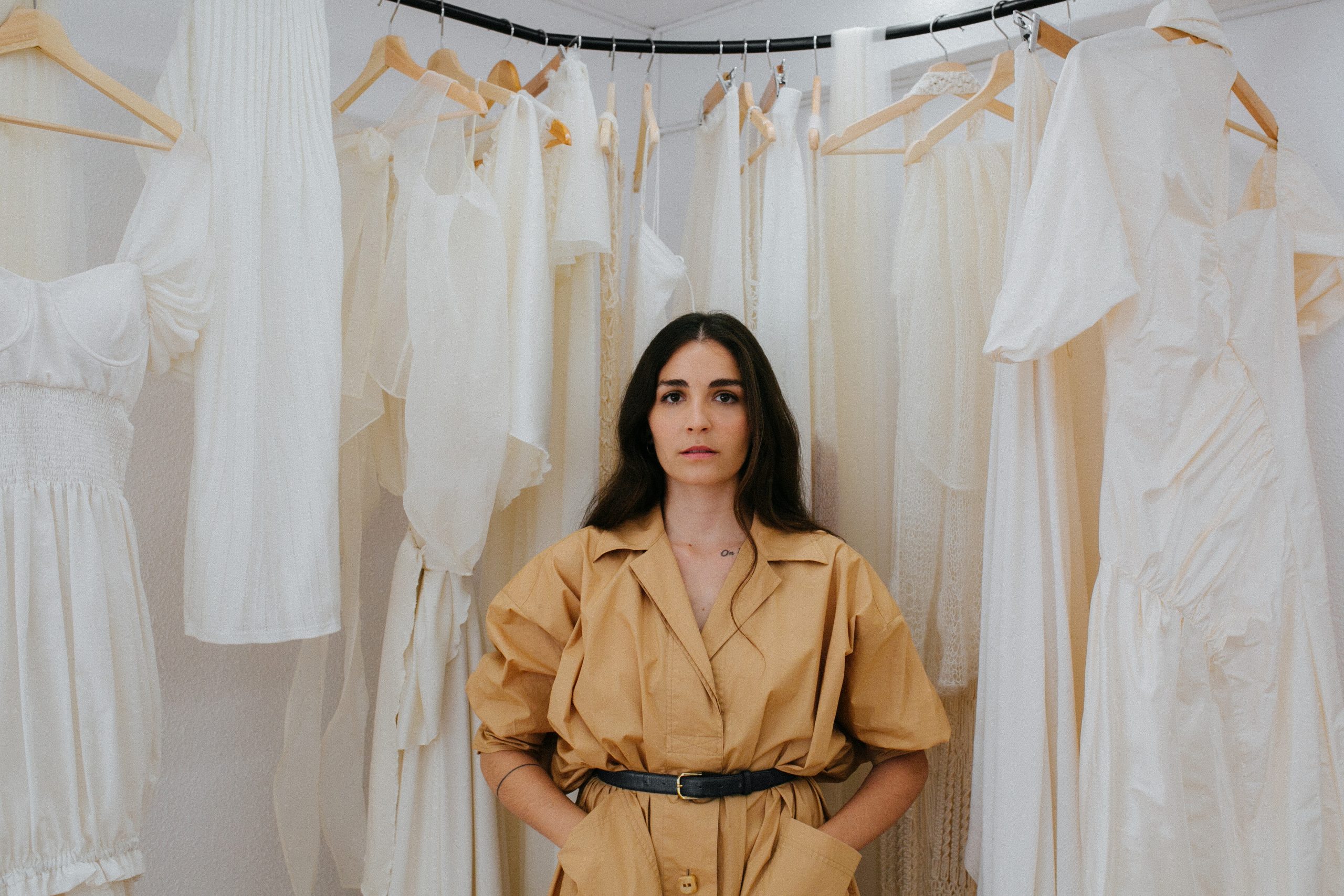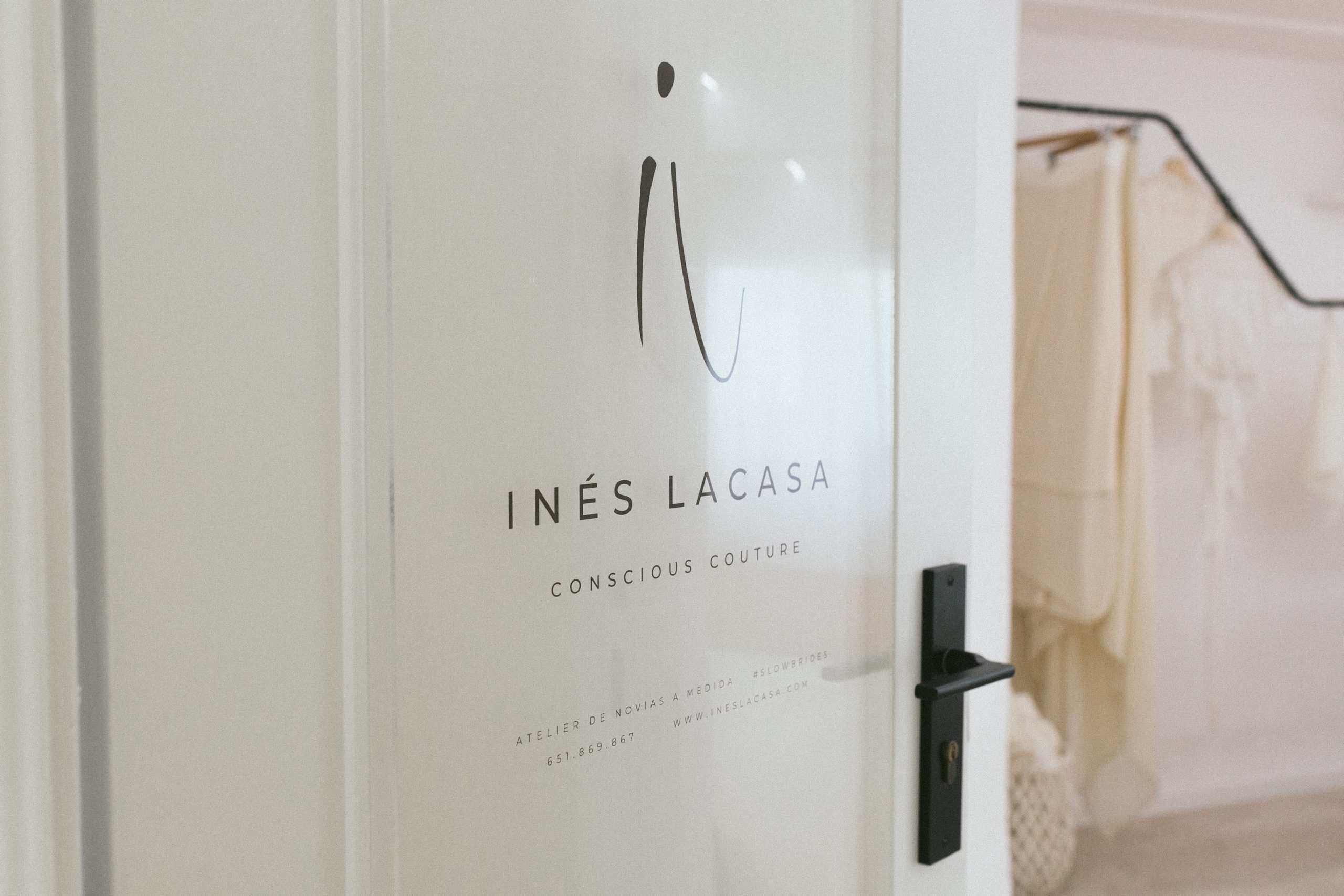THE REVOLUTION OF SUSTAINABLE BRIDAL FASHION IN SPAIN
As soon as I discovered Inés on social media and reached out to her, I had a feeling we would connect instantly. And my intuition didn’t fail me.
She is the granddaughter of Inés, a seamstress from a small village in Cádiz (south of Spain), and the daughter of Inés, a woman with golden hands for embroidery, cross-stitch, macramé, and many other crafts. Inés has worked with renowned designers such as Roberto Torretta, Purificación García, and Marcela Mansergas, as well as on various sustainable fashion collaboration projects.
I’ve had the privilege of interviewing her and closely following her work for months. Today, Inés Lacasa welcomes us into her atelier to bring you this exclusive moment on our blog, where we talk about bridal fashion and sustainability—two inseparable concepts for Inés Lacasa.
1. Let’s start from the beginning —
What defines this market shift towards more sustainable bridal fashion and how do you envision the future of fashion?
I believe this is not just a trend in the bridal world but in fashion as a whole. I’d even say it’s something that impacts almost every industry and sector. More than a trend, sustainability is becoming a necessity.
It’s very difficult to predict the future of anything, but I think fashion will eventually return to its roots—the much-acclaimed slow fashion movement: reducing the number of collections, creating smaller productions with less environmentally harmful processes and materials. Local, proximity-based production that values the people behind the work and preserves artisanal and handcrafted techniques.
2. For all the brides considering a sustainable wedding dress —
What distinguishes a sustainable gown from a conventional one in terms of processes, fabrics or stock?
Sustainability is a broad and somewhat undefined concept. There has been a lot of greenwashing, which can mislead consumers. Sustainability is not about a specific type of product with set characteristics—it is a statement of intent that should be embedded in every part of the process. This is how we approach it in our brand, which is why every decision we make is guided by our concept: CONSCIOUS COUTURE.
Our production model is always made-to-order, meaning every piece is created with purpose. We carefully control our processes and suppliers, prioritizing collaborations with local projects to reduce the environmental impact of logistics. For example, one of our main production partners is a women’s cooperative that operates its workshop using clean energy.
We offer brides natural, sustainably produced fabrics such as organic cotton, linen, and peace silk—a cruelty-free silk produced without harming the silkworms. Following the principles of circular economy and zero waste, we recycle most of our fabric scraps to create new textiles.
Even our labels are handcrafted from residual cotton from the textile industry, mixed with seeds, so that brides can plant them and give back a little of what we’ve borrowed from nature.
3.You are the first Conscious Couture brand in Spain.
Can you explain this concept at Inés Lacasa?
Conscious Couture is a concept created by my brand that clearly and simply defines our philosophy and way of working: Haute Couture with a conscious approach.
We say that Conscious Couture is traditional artisanal sewing, now more relevant than ever. Innovation is not just about creating something new—it’s also about recovering and reinterpreting tradition from a fresh perspective. Right now, we need to unlearn and return to the essence of craftsmanship with a renewed vision. It’s about bringing back the care and dedication that once made even the simplest things truly unique.
4. How would you describe the brides who order a custom wedding dress from you?
There isn’t a single definition for our brides because we work with all kinds of clients. However, I would say they are brides who trust me to collaborate closely in creating their dream dress—even if they don’t yet know exactly what that looks like.
We love working with open-minded brides who are eager to explore different and innovative ideas. But beyond aesthetics, what truly excites us is knowing that our clients choose us because we share the same values. We create a genuine bond with them, and they want those values to be part of such a meaningful moment in their lives.
5. What are your sources of inspiration for your designs?
Without a doubt, my main source of inspiration is the client. It’s essential for me to get to know her, connect with her, and truly understand her vision. I want to know what she likes, what her dreams and expectations for this day are, and what makes her feel comfortable. I use all of this as a foundation to create something unique for her.
Another clear inspiration is craftsmanship. For me, every form of craftsmanship holds an inherent beauty. That’s why I strive to incorporate it into each design, honoring both the technique and the artisan behind it.
Materials also inspire me deeply—their textures, colors, movement, drape, light, and shine. Often, the fabric itself guides me as I work with it and combine it with other elements.
6. What is the logistical process if a bride wants a custom-designed dress but cannot visit the atelier in person?
We see our process as a journey we take alongside our client. As I mentioned before, as a designer, I love to truly get to know and connect with each bride. This is a fundamental part of my creative process, ensuring that we design the perfect dress for her. This connection is almost impossible without meeting in person and working together in the atelier.
Additionally, since our work is exclusively made-to-measure, every custom design requires in-person fittings. It’s essential to try the dress on the bride’s body to refine every detail and achieve the perfect fit.
7. Once the wedding takes place, what options do brides have to reuse their wedding dress?
More and more brides are looking for versatile designs that don’t limit them to a single use. They want dresses that make them feel special not just on their wedding day but every time they wear them, bringing back memories of that magical moment.
As a designer, I find this shift in mindset fascinating—not only because it allows for different versions of the same dress but also because it gives me more creative freedom to develop ideas and take on new challenges.
There are many ways to repurpose a wedding dress, depending on the design. The most common options include shortening the train, dyeing the dress, or transforming part of it into a new garment, such as repurposing the detachable overskirt into a separate piece.






